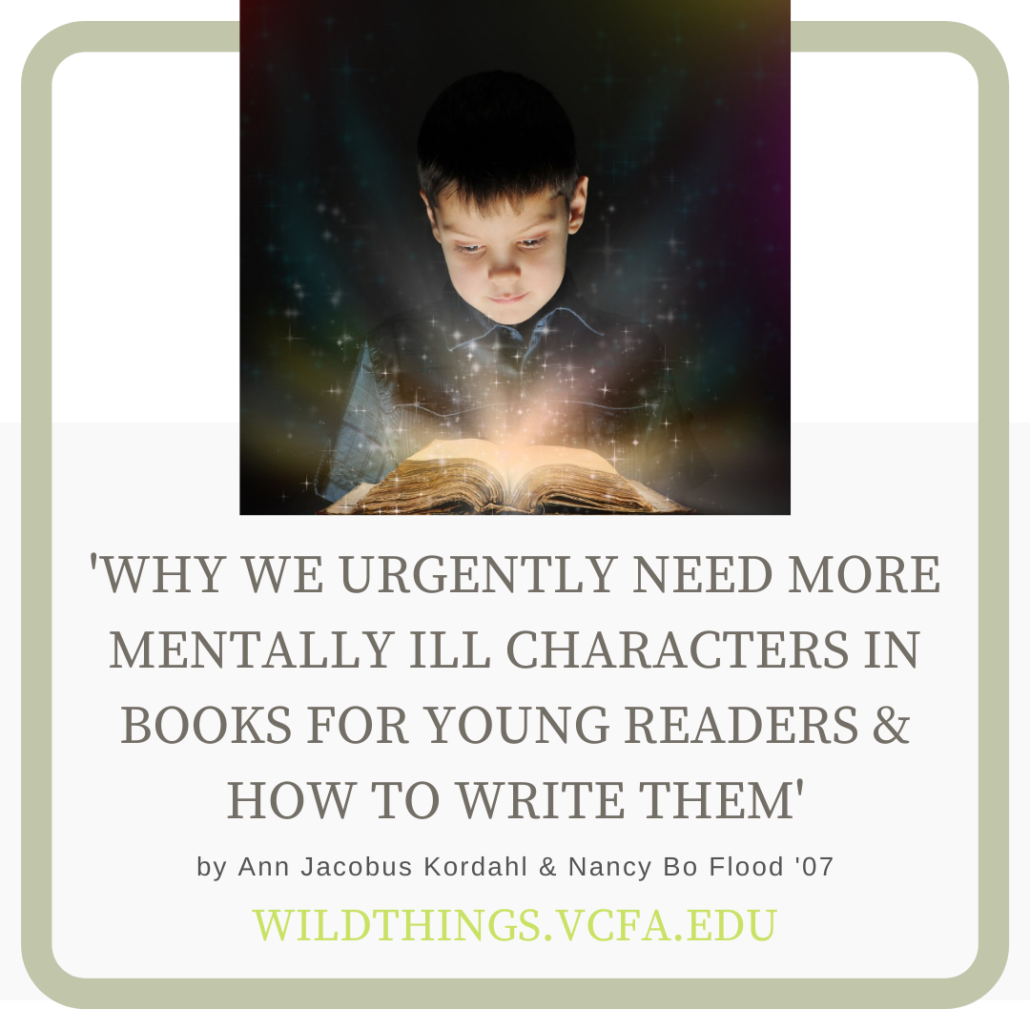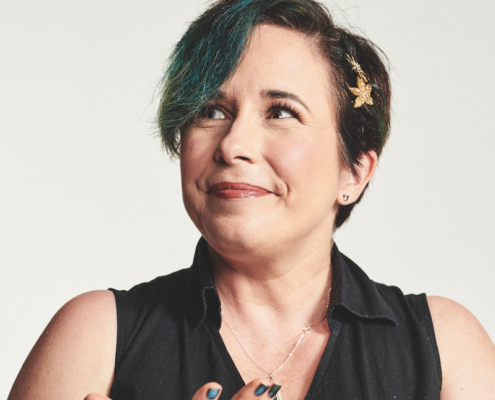‘Why We Urgently Need More Mentally Ill Characters in Books For Young Readers & How to Write Them’ by Ann Jacobus Kordahl & Nancy Bo Flood ’07
Mental illness is usually invisible but is one of the most frequent disabilities affecting children. One in six children, and one in five adults are currently struggling with a mental health condition [1] and many more young people are impacted indirectly via care givers, siblings, or other loved ones.
Early indications are that for all populations, mental health issues during the pandemic have doubled. [2]
Isolation, shame, and silence, thanks to STIGMA, impede interventions (the average delay between onset of symptoms and treatment is eleven years, [3] ) and may lead to life-threatening complications, even death.
Suicide is the second leading cause of death for teens and young adults in the US.[4] 90% of these young people had an underlying, untreated mental health condition. [5]
For a young reader, the right book at the right time can help normalize what likely feels shameful and overwhelming. Every story out there helps diminish stigma and can encourage a reader to reach out for life-saving support.
We as storytellers can offer a young reader a realistic but optimistic story about a character dealing with mental illness themselves or in their family, at the same time they’re doing all the other things characters do.
Who should write about characters with mental illness?
The need for stories that deal with any aspect of this subject accurately and responsibly is so urgent that anyone who is interested in telling them, should—as long as the writer gets it right.
How do I get it right?
- Research! Accurate information is widely available online. The National Alliance on Mental Illness (NAMI), the National Institute for Mental Health (NIMH), American Foundation for Suicide Prevention (AFSP), The Child Mind Institute, The Trevor Project, and the Centers for Disease Control (CDC), to name but a few.
- If a writer can draw on personal experience of coping with mental illness, all the better
- Regardless, ask expert readers to vet your manuscript, including those who deal with the illness depicted, and those who treat it
- Avoid negative tropes and stereotypes (see below)
- Ultimately show characters (young people especially) seeking and receiving support from family or friends, and importantly, from professionals
- Show characters following treatment plans and coping successfully
Points to consider for responsibly creating a compelling mentally ill character:
- First, ask yourself what you want your reader to understand, learn, or remember about mental illness after reading your book
- Is the outcome hopeful—but realistic?
- Is the mental illness acknowledged with the proper diagnosis and nomenclature?
- What aspects (emotional, mental, and physical) of mental illness are part of the character’s motivation?
- What about self-destructive behaviors /choices /relationships with other characters?
For main characters with mental illness:
- How does mental illness interfere with what the MC wants? What must change so they can get what they want?
- Is seeking support from friends, family, trusted adults, teachers, etc. part of the story line?
- Is obtaining professional help and the journey toward recovery or optimum coping part of the story line?
What should I avoid when writing about mental illness for young readers?
With young readers, writers’ responsibilities go further. The perfect mental illness book for young readers has possibly not been written, but numerous erroneous stereotypes, false generalizations, and poor representations persist in fiction and popular culture. These include:
- Romanticizing or sensationalizing suicide, including graphic details of an attempt, or worse, instructions
- Mental illness as a sign of moral weakness, a sin, character flaws, or some personal choice
- Mental illness as a result of poor parenting (abusive parenting can lead to mental illness, but good parenting cannot protect a child from it as so many of the causes are not within parents’ control) [6]
- A person can think positively or make lifestyle choices that will completely erase their mental illness
- Conversely, that mental illness is incurable or guarantees a poor outcome
- Mentally ill people are violent and dangerous. (Dangerous, violent people are sometimes mentally ill)
- Love alone can cure mental illness
- Meds don’t work. (Finding the right medications can be a difficult process, sometimes with unpleasant side-effects, but medication can improve symptoms and help return sufferers to function)
- Mentally ill people are treated against their will. (If someone is perceived as a danger to themselves or others, coercion can enter the equation, but treatment without the cooperation and participation of the patient doesn’t work and causes trauma. [7])
- Romanticizing mental illness as a gift that brings creativity and quirkiness, i.e. avoid the manic-pixie-dream girl/boy, beautiful, tragic, non-conformist trope
- Using pejoratives like “cracked,” “loony,” “batty,” going “ape.” We don’t call someone with heart disease or diabetes names or compare them to animals. Half of characters acknowledged as mentally ill in US popular media are shown hurting or killing others, or in content for the young, are played as ridiculous for laughs.
Statistics show that the number of young people dealing with mental illness is increasing alarmingly. Through the power of story, writers can help eradicate stigma by showing that, like physical illness, mental illness is a normal part of a character’s life and can be treated and coped with successfully, at the same time characters desire, strive, fail, learn and transform.
[1] NAMI: National Alliance on Mental Illness. Mental Health by the Numbers. Retrieved from https://www.nami.org/mhstats, February 16, 2021
[2] Mclernon, Lianna Matt. Center for Infectious Disease Research and Policy (CIDRAP). Ibid.
[3] NAMI. Ibid.
[4] Kann L, McManus T, Harris W.A., et al., Youth Risk Behavior Survey, United States, 2017. Surveillance Summaries, Centers for Disease Control and Prevention (CDC) U.S. Department of Health and Human Services, Atlanta: June 15, 2018. Vol 67, No. 8. P. 24
[5] NAMI. Ibid.
[6] “Myths and Stereotypes About Those With Mental Disorders.” Centennial Mental Health Center of Colorado, Crisis Services. 2019. Retrieved from https://www.centennialmhc.org/wp-content/uploads/2017/12/Myths-and-Stereotypes-about-Those-with-MH-Disorders.pdf
[7] Trauma Within The Psychiatric Setting: A Preliminary Empirical Report. (2003). Administration and Policy in Mental Health, 30(5), 453-460. Retrieved from http://www.psychrights.org/Articles/PsychiatricTrauma.pdf June 1, 2019







